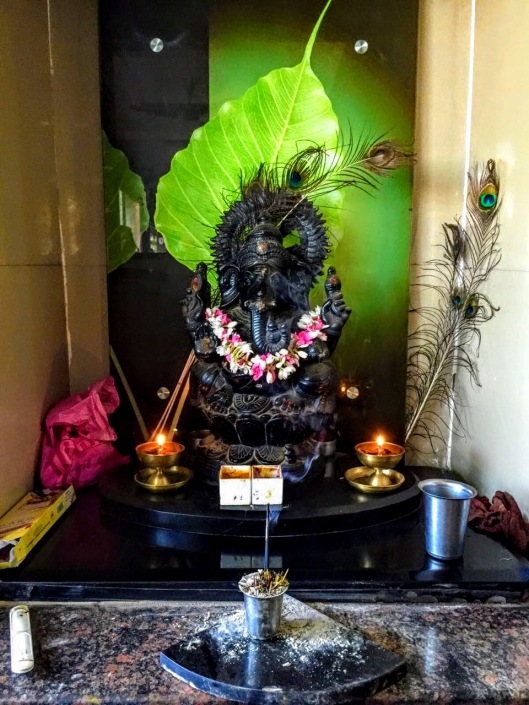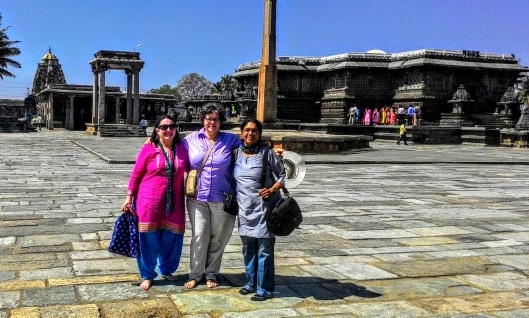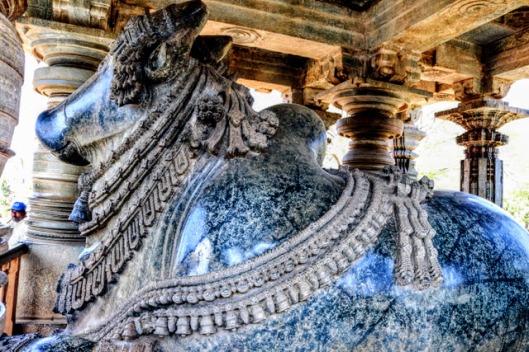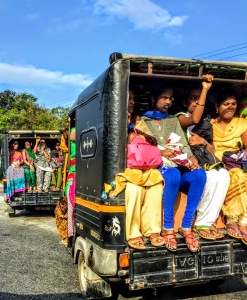Tags
book review, humor, India, inertiaspeaks.com/, Karnataka, Please don't Ask For Extra Glasses, Preeti Rajput, travel

This beautiful Ganesh presided over our early morning breakfast stop. [This and all images below (c)Janine Smith & Jayalakshmi Ayyer 2017]
The art of passing…
My travel besties, Jaya and Janine, showed up in Bangalore a day before I swanned in courtesy of a first-class upgrade. Our driver showed up with the idea that we would be ready to leave at 0:dark-thirty that morning. My luggage did not show up at all.
This wasn’t a problem, because I’d left Jaya with a batch of fabric after our last trip, and her tailor had several salwar kameez (pleated/drawstring trousers, tunic, and dupatta/scarf) outfits ready to go. Plus when Janine was in the Washington DC Costco loading up on emergency snackage, she texted a picture of a wonderful pair of walking shoes. Being the old ladies we are, Jaya and I each demanded a pair—the new trip uniform.
The plan was that we’d begin our Karnataka trip with a few temples to get back into the swing of India travel, fine-tune the relationship with our driver, and fight the random urge to slip into a jet-lagged coma. (There might be drooling…)
Janine and I were so sleep-deprived, we couldn’t have told what time it was. Or what day. (Okay, there was definitely drooling…) But the sounds (non-stop honking), the sights (cows and other animals wandering along the freeway amid entire families on motorbikes or crammed into auto-rickshaws), and the smells (we were back on two-hour feedings) of India soon had us raring to go. (And just in case that should become the literal truth, I packed the toilet paper, Jaya packed the bottled water, and Janine packed the Imodium.)
Frankly, I can’t tell you much about that first trip except that we had an excellent breakfast at Parijata Restaurant under the watchful eye of a cheerful Ganesh in his incense-burning altar with the adjacent large-screen TV showing devotional videos, and a confusing collection of ceramic chef-heads.
When you arrive at an Indian tourist attraction, the decision on whether to hire a guide is only one of many you’ll need to make (along with how long Western feet can go barefoot on hot flagstones when required to shed shoes at temples, if you should be the ONLY one in all of India obeying the NO PHOTOGRAPHY signs, and how much toilet paper you can stuff into your pockets). Our general experience is that guides spend most of their time reprimanding us. “This way Madam. Madam, look here. Madam, come come. Madam I am telling you…”—by which point Madam has either wandered off to take pictures (Janine), actively interrupted his script by asking random questions (me), or lost all patience and started giving the tour herself since she clearly knows a LOT more history, better stories, and English (Jaya).

Towering 16th century gopura marks entrance to Chennakesava Temple at Belur (Karnataka State) India, with traditional temple pillar framed in gateway.
Our usual technique has been to read up on the history and significant features before arriving at a site. But if it’s large, if the signage is nonexistent, and if the architecture stunning, we might opt for the guide. We have yet to be glad we did so, and this was no exception. Concluding the expected bargaining session—where the initial fee demanded was reduced to a third despite presentation of a government-issued card documenting his status as a duly-registered guide—our guide directed us to remove our shoes.
After barking out orders to follow him around the exterior of the temple—where stone tiles were already frying our bare feet—and pointing out the obvious features already described at the entry sign, our guide shepherded us into the dim interior. There was a little traffic jam of various tour groups, during which our guide sharply reprimanded several people for touching the carvings. Then he showed us how fine the carving work was by touching them between their carved layers. Repeatedly.

The Chennakeshava Temple, part of the original capital of the Hoysala kings, was commissioned in 1171 by the Hoysala King Vishnuvardhana. Repeated in several places was the tale of boy Prince Sala, who saved the city from a lion.
Finally, the guide briefly turned a searchlight to the intricately carved dome above. We now, he informed us, owed the owner of the searchlight an additional thirty rupees. Perhaps suspecting that a large tip was not coming his way, the remainder of our tour was briskly concluded with a demand from a hitherto invisible attendant for thirty rupees to reward his vigilant protection of our shoes.

The exterior of the temple is covered by thousands of carved sculptures, including 644 elephants—each of them different.
As we sorted our six identical shoes, our guide gabbled off a description of the gravity-defying central pillar and waited hopefully for the additional largesse an unimpressed Jaya would shell out the second hell froze over. The guide wandered off in search of less demanding clients and that’s when I realized that something was very different about this trip. Whenever we’re in India, Janine and I stick out like…well like two pasty white ladies wearing sensible travel clothes amid a sea of Indians in gorgeously colored clothing. Within in moments of arrival, we’d be swamped by vendors—from tiny children to senior citizens proffering strings of flowers, packages of stickers, postcards, flutes playing wobbly Frere Jacques, stone animals—”hand-carved, Madam”, and random strings of gaudy jewelry. The vendors would have to compete with Indian tourists crowding around and shyly asking “Selfie Madam?”.

This would totally be my profile picture if I could for the life of me remember how to change it on WordPress.
But this was the day all that changed, at least for me. I was wearing my bright new kameez (tunic) and salwar (trousers), along with a large pair of sunglasses and a hat, and soon discovered they were like an invisibility cloak. The usual crowds ignored me completely while swarming around Janine, demanding purchases and photos. I hung back and tried to look like a sophisticated Mumbai resident, waving off supplicants with a negligent hand. Meanwhile, Jaya and I watched Janine take photos with everyone and try to be polite:
Vendors 1-5: “Madam wants postcard/flute/elephant?”
Janine: “No, thank you. But they are very nice.”
Vendors 6-10: “Madam wants flute/postcard/elephant?”
Janine: “No, I…”
Bravest Indian Tourist: “Selfie with me?”
Vendors 11-15: “Elephant Madam? Postcard? Flute?”
Janine: “Sure, we can take our picture together. Where are you from?”
Vendors 16-infinity: “Madam wants postcard/flute/elephant?”
Surprised Indian Tourist: “I’m from India. Selfie with me? And the other twenty or thirty people I came with?”
Janine (to Jaya, while I’m laughing hysterically): “Help me.”
All the Vendors: “MADAM WANTS ELEPHANT? FLUTE? POSTCARDS?”
Janine (to me): “I will get you for this.”

Standing (barefoot) in front of the famous Gravity Pillar, which stands on only 20% of its base, perfectly balanced with no external support.
Who knew passing for Indian while simultaneously throwing one of my oldest friends under the bus would be so much fun? Win-win.

Stunning relief sculptures make the Chennakeshava Temple one of the architectural jewels of the south of India.
After a traditional tali lunch eaten off banana leaf ‘plates’, we were ready to face the next temple, this time sans guide. The Hoysaleswara Temple in Halebid is actually two temples honoring Shiva. Each has a pavillion facing the entrance which contains twin statues of Nandi (the bull companion of the god Shiva). The monolithic sculptures watch with timeless serenity over the stunning remains of the twelfth-century Halebidu temple complex that was still not completed when sacked by fourteenth-century invaders who smashed the faces on the hundreds of carvings.

Nandi, the bull companion of the God Shiva, at Halebidu Temple complex. This massive work is one of a pair of Nandi sculptures which guard the outside of the temple.

Hoysaleshwara Temple, Halebid. The bands of individually unique relief sculptures are typical features of architecture of Hoysala, a kingdom which ruled in south India from the 10th to the 14th centuries. Profusely carved figures start with elephants on the bottom and work up through lions, horsemen, scenes from daily life, etc.
On the way back to Bangalore, we stopped at the same restaurant. Ganesh’s incense had burned down and the TV was playing an Indian soap. But in the next room over, an enthusiastic group were playing music and chanting Hari Krishna songs.
We arrived back at Jaya’s kids’ place in Bangalore in a fog of honking vehicles, jetlag, and too much good food to find that her daughter-in-law had made more food. Of course. We were in India.
I asked Janine if she wanted to take a selfie with me.
My special, delighted thanks to Preeti Rajput, a Delhi writer who generously reviewed Please Don’t Ask For Extra Glasses. Please check out her wonderful blog at https://inertiaspeaks.com/ .
 Book Review from Preeti:
Book Review from Preeti:
I don’t remember the last time when I had so much fun reading a travel experience. Barb is a witty author with a laudable sense of humor. She has kept the book alive with her clever one-liners and individual style. This book revives the travel experience of a lively trio- Jaya is the leader who can take no-nonsense, Janine is a photographer, and Barb is a shopaholic. In initial experiences, I envisioned Barb, Jaya, and Janine to be young women in their late 20’s on an all-girl trip until I encountered the word “Grandmother”. I went back and checked the pictures, and it further enhanced my enjoyment.
The book starts with a humorous exchange of communication for VISA approval and sets the right tone for further chapters. In all 16 chapters, the author has narrated her experience of travelling across Rajasthan and Gujrat. I have been to most of the destinations, and through the author, I have seen them in a different light. While travelling in Rajasthan, she couldn’t contain her childish excitement for camels and Elephants. Even though I live in India, still camels and elephants are scarce to be seen in Delhi. I can relate to the thrill.
I always wanted to know the thoughts of international travellers for my country. This book gave an appropriate opportunity. It is strange to know they also have to face similar tourist traps, scammers, and thugs. Looks like there is no escape for anyone. The book starts with crashing a wedding, and they also encountered a bride on a horse. Being a native Indian, it is unusual, and I have not seen it in my entire life. It’s the bridegroom who sits astride the horse.
There are nowhere boring stats and history in it. Wherever needed it is transformed into stories. This book is thoroughly strived to relive the marvelous memories. In the end, there are some relevant travel tips for markets, food, shopping, etc. As the book ends, they didn’t want to end the trip, and I also felt the same. I wish it could go on and on. I relished and lived their every experience.





Thank you for introducing into a very interesting book, Barb! Congratulations, to a wonderful journey. India is so colorful and fantastic. Michael
LikeLiked by 1 person
Thanks so much Michael. Janine and I have been used to visiting Jaya in India every year. So this pandemic year has been tough, but it helps to do some virtual visits!
LikeLiked by 1 person
Thats great, and i am sure you had enjoyed. The images are definitely wonderful for a virtual visit. Thank you, and have a beautiful weekend! Michael
LikeLiked by 2 people
Love it!
LikeLiked by 1 person
Me too!
LikeLiked by 1 person
I can imagine ))
LikeLiked by 2 people
I have been unable to find your book. Please let me know where I can download it from.
LikeLiked by 1 person
I’m so sorry–can’t figure out why the link isn’t working. You could try this universal link (which is supposed to figure out your home Amazon store and take you there):
http://getbook.at/DontAskForExtraGlasses
Or your could try one of these links:
Amazon USA: https://www.amazon.com/dp/B08WHVRDQ2
Amazon UK: https://www.amazon.co.uk/dp/B08WHVRDQ2
(But the easiest is just to let your sister know which format you prefer and have her send it to you. Just sayin’…)
LikeLike
What fun, I enjoyed ‘Plates’ so I’m sure I will enjoy the latest book.
LikeLiked by 1 person
What a lovely comment! I hope you like the book.
LikeLiked by 1 person
What a wonderful review, Barb.
LikeLiked by 1 person
I’m still dancing. (Peri is concerned.)
LikeLiked by 2 people
Next trip I expect you to come just a tad bit more south of Karnataka. I promise I’ll pester Janine for a selfie and make your day.
LikeLiked by 2 people
You’re on! (Janine is one of our best friends. Jaya and I would go almost anywhere to torture her.)
LikeLiked by 2 people
Very nice and sweet..like it
LikeLiked by 1 person
Hoping to find one more
LikeLiked by 1 person
Went straight over to buy this book on Amazon and ended up buying all three of your available books there. Apart form the guaranteed laughs they’ll contain, they were delightfully inexpensive on Kindle! (Cheap laughs?)
LikeLiked by 1 person
Thanks!
[sniff!] Nope, not crying. Much…
LikeLiked by 1 person
Loved this post!! The temple really is amazing. I definitely need those geeky Costco walking shoes. Congratulations on a great book review, Barb!
LikeLike
This was such a fun read- I have always wanted to visit India- and the food looked amazing!
LikeLike